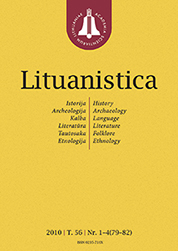LituanisticaWHAT?
 ISSN 0235-716X |
2006 m. Nr. 1 Onimų reikšmės tyrimai tekstynų lingvistikos metodu
The goal of this research is to tackle several issues, specifically to analyse the connotations of the onyms Arabian and Saudi Arabia and to confirm that proper words connote certain meanings. The meanings of onyms are compared with the meanings of the adjective Arabian. The Corpus of the Contemporary Lithuanian Language, compiled in Vytautas Magnus University and comprising more than 100 million words, was chosen as a source of onyms meaning research. The methodology of Corpus Linguistics was applied in this research. 3851 concordances containing the onyms Arabian, Saudi Arabia and the adjective Arabian were analysed. The reference is made to the meaning model created by J. Synclair on the basis of cirpus analysis. The main idea of this model is that the meaning is not concentrated on one word but is distributed among a few words that are close to each other. Four meaning determination criteria were indicated: 1) collocations – a frequent co-occurrence of words, 2) colligations – a frequent co-occurrence of words with conjunctions, particles, 3) semantic preference – a lexical set: the class of semantically related lemmas, 4) semantic prosody – an implicit context of the word and its connotations. The results of the research allowed the following conclusions: 1) the contexts of usage of the noun Arabian according to the fluency are the following: politics and war, scientific and cultural achievements, sport, business, criminality, traditions and exotic topics; 2) the onym Saudi Arabia most often is used in the context of politics, sports, economics and culture; 3) the contexts of usage of the adjective Arabian are not that numerous; it is mainly used in the contexts of culture and exoticism. The onyms Arabian and Saudi Arabia connotate most of the things. They are endowed with various meanings emphasizing terror, criminalities, culture or traditions, and differently appreciated elements. However, it is important to highlight that meanings and connotations are determined only in a certain context.
|
Numeriai:
2011 - T.57 Nr.1, Nr.2, Nr.3, Nr.4 2010 - T.56 Nr.1-4 2009 - T.55 Nr.1-2, Nr.3-4 2008 - T.54 Nr.1, Nr.2, Nr.3, Nr.4 2007 - T.53 Nr.1, Nr.2, Nr.3, Nr.4 2006 Nr.1, Nr.2, Nr.3, Nr.4 2005 Nr.1, Nr.2, Nr.3, Nr.4 2004 Nr.1, Nr.2, Nr.3, Nr.4 2003 Nr.1, Nr.2, Nr.3, Nr.4 2002 Nr.1, Nr.2, Nr.3, Nr.4 2001 Nr.1, Nr.2, Nr.3, Nr.4 |